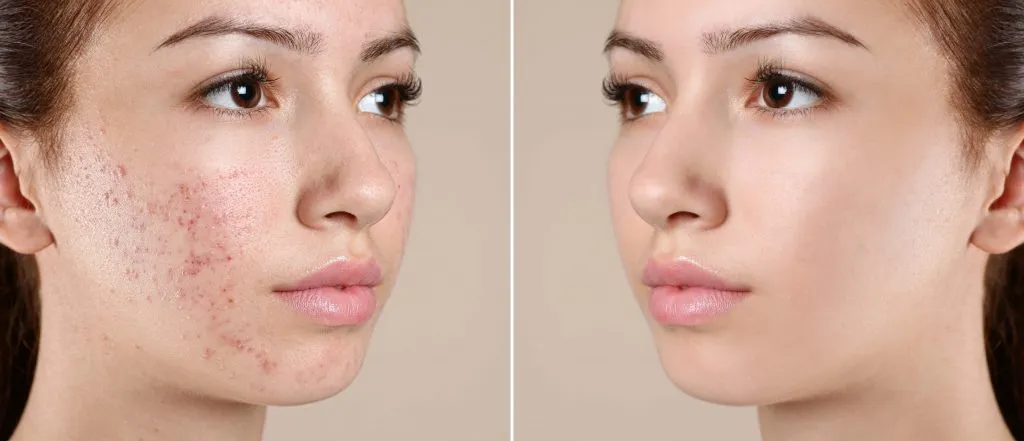What’s the Difference Between Acne and Pimples?
Almost everyone has suffered from acne and pimples at one or another time in life, isn’t it! Acne is commonly called pimples or pimples as acne; let us know in detail how they differ in medical terms.
The difference between acne and pimples is that acne is a disease and pimples are one of its symptoms. Acne is a condition affecting the skin’s hair follicles and oil glands. Pimples are nothing but a less severe form of inflammatory acne.
Acne can be classified as Acne Vulgaris, usually seen at puberty, and Acne Rosacea, later in life after puberty. Both these kinds occur on the face, but also can involve on neck, shoulder, chest, back, and arms. The presentation may differ on the severity of involvement.
Acne can further be classified as:
Acne is a disease of the skin, occurs when pores of the follicle on the skin become clogged with dead skin cells, oil, or bacteria.
Acne is clinically characterized by whiteheads, blackheads, pimples, nodules, and cysts. Increased oils (sebum) produced by the sebaceous glands, skin cells (keratin), and hair follicles together form a plug, clogging the skin pores, resulting in a non-inflammatory type of acne(whiteheads and blackheads). These clogged pores provide favorable conditions for propionibacterium acne to grow and get trapped underneath the skin leading to infection and inflammation. As the follicle enlarges, the wall may rupture into a deeper layer of the skin resulting in the inflammatory type of acne (pimples-papules & pustules in which the inflammation is on the skin surface and severe acne in which the inflammation is still deeper called nodules and cyst).
The most common cause for increased secretion of sebum is hormonal changes, as seen in puberty, during menstrual cycles, pregnancy, hormone therapy, and stress. Other few causes influencing the sebum secretion are genetics, intake of certain medicines such as corticosteroid, exposure to harmful chemicals, high levels of humidity and sweating, greasy cosmetics, consumption of oily, spicy and carbohydrate-rich diet.
Different symptoms can indicate different types of acne and include:
Non-inflammatory acne:
Blackheads appear as a tiny, dark bump on the skin as clogged hair follicle; the debris inside the follicle gets oxidized Whiteheads appear as white or skin-colored bumps; because the follicle is completely plugged and are not exposed to the air
Inflammatory acne:
- Inflammatory acne: depending upon severity and depth of involvement.
- Pimples fall into a less inflammatory type of acne called as a papular and pustular type.
- Papules appear as small raised, pink or red bumps (with no white pus)
- Pustules appear as raised red bumps with white pus.
- Nodulocystic acne falls in severe inflammatory type.
- Nodules appear as hard, large red painful lumps
- The cyst appears as hard, large, red painful lumps with cysts.
Let’s know a few of the general measures to manage acne as listed below:
- Wash face: Wash your face gently at least twice a day using warm water or a mild cleanser to remove the excess oil, dead skin cells, and dirt; decreasing the possibility of acne. Avoid harsh scrubbing of the face.
- Use oil-free makeup, lotions, or moisturizer.
- Avoid touching and popping or squeezing your face with hands as they bacteria which may lead to secondary infected and scarring.
- Avoid abnormal exposure to sunlight which causes redness or inflammation and further leads to hyperpigmentation. Use wide-brimmed hats and oil-free sunscreens.
- Drink plenty of Water: at least 1.5-2 liters of water every day to detoxify your body and skin.
- Avoid junk food, dairy products, and foods processed in high sugar as they may trigger acne. Consume more fresh fruits, vegetables, and whole grains.
- Do regular exercise: which is good for the body, mind, and skin.
- Sleep well: for about 6-8 hours.
- Relieve Stress: change in necessary lifestyle may relieve stress; as stress increases internal cortisol levels, which in turn can increase the oil secretion.
- Keep Hair away from falling on the face; as oils and gels applied to your hairs will make oily or may irritate your skin coming in contact with it.
- Medication: Medicines without prescription called OTC products can be tried with caution. If OTC medicines failed to work, better to consult a dermatologist. They may prescribe topical medicines such as benzoyl peroxide (2.5%), salicylic acid, retinoids, clindamycin and or with oral antibiotic and retinoids or hormonal, depending upon type and severity of acne.
- Interventional therapy such as chemical peeling, microdermabrasion, photodynamic therapy, laser treatment, may be required in resistant cases of acne not responding to the above-mentioned measures and therapy.
Acne and pimples if not treated effectively in proper time may lead to scarring; which will persist a lifetime.

